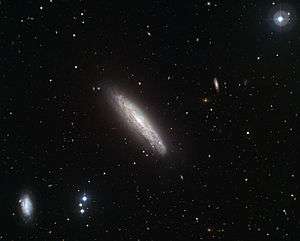NGC 4666
| NGC 4666 | |
|---|---|
|
The superwind galaxy NGC 4666. Credit: ESO/J. Dietrich.. | |
| Observation data (J2000 epoch) | |
| Constellation | Virgo |
| Right ascension | 12h 42m 34.6s[1] |
| Declination | −00° 11′ 21″[1] |
| Distance | 80 Mly |
| Apparent magnitude (V) | 10.8[2] |
| Characteristics | |
| Apparent size (V) | 4.5[2] |
| Other designations | |
| NGC 4666, 2MASSW J1245072-002740, SDSS J124508.59-002742.7, [CHM2007] LDC 904 J124508.67-0027428, 6dFGS gJ124508.6-002743, 2MASX J12450867-0027428, SINGG HIPASS J1245-00, [CHM2007] HDC 720 J124508.67-0027428, HIPASS J1245-00, MCG+00-33-008, UGC 7926, [M98c] 124235.1-001114, IRAS F12425-0011, 2MFGC 10050, UZC J124508.0-002744, [NLB95] f861g005, IRAS 12425-0011, MRC 1242-001, Z 1242.6-0010, LEDA 42975, PMN J1245-0027, Z 15-15. | |
NGC 4666 is a spiral galaxy in the constellation Virgo. It is noteworthy for its vigorous star formation, which creates an unusual “superwind”[3] of out-flowing gas. This wind is not visible at optical wavelengths, but is prominent in X-rays, and has been observed by the ESA XMM-Newton space telescope.[4]
A Type Ia Supernova was detected in NGC 4666 on 9 December 2014.[5][6] ASASSN-14lp is located 12 arcseconds from the center of NGC 4666.
External links
- SEDS: NGC 4666
- The Superwind Galaxy NGC 4666, ESO Press Release.
References
- 1 2 "SIMBAD Astronomical Database". Results for NGC 4666. Retrieved 2010-09-21.
- 1 2 "The Interactive NGC Catalog Online". Results for NGC 4666. Retrieved 2010-09-21.
- ↑ The Superwind Galaxy, ESO, 1 September 2010.
- ↑ Extra-planar Hot Gas and Magnetic Fields in the Superwind Galaxy NGC 4666, ESA, Retrieved 24 February 2011.
- ↑ ASAS-SN Discovery of A Bright Probable Supernova in NGC 4666
- ↑ Supernovae ASASSN-14lp in NGC 4666
This article is issued from Wikipedia - version of the 7/19/2015. The text is available under the Creative Commons Attribution/Share Alike but additional terms may apply for the media files.
